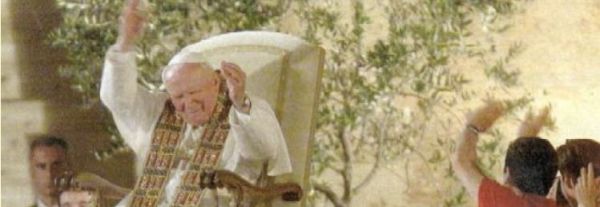3. In the New Testament, God's forgiveness is revealed through Jesus' words and deeds. In pardoning sins, Jesus shows the face of God the merciful Father. By opposing certain religious tendencies marked by hypocritical severity towards sinners, he shows on various occasions how great and profound is the Father's mercy towards all his children (cf. Catechism of the Catholic Church, n. 1443).
The high point of this revelation can be considered the sublime parable which is usually called "the prodigal son", but which should be called "the merciful father" (Lk 15: 11-32). Here God's attitude is presented in terms that are truly overwhelming in comparison with human criteria and expectations. The father's conduct in the parable can be understood in all its originality, if we keep in mind that in the social context of Jesus' time it was normal for sons to work in their father's house, like the two sons of the vineyard owner, of whom he speaks in another parable (cf. Mt 21: 28-31). This system continued until the father's death, and only then did the sons divide the property they had inherited. In our case, instead, the father agrees to give the younger son his share of the inheritance and divides his possessions between him and his elder son (cf. Lk15: 12).
4. The younger son's decision to be emancipated, squandering the goods he had received from his father and living a dissolute life (cf. ibid., 15: 13), is a shameless rejection of family communion.
Leaving the father's house clearly expresses the meaning of sin as an act of ungrateful rebellion with its humanly painful consequences. Human reasonableness, in some way expressed in the elder brother's protest, would have recommended an appropriately severe punishment for the younger son's decision before he could fully rejoin the family.
But the father, catching sight of him while still a long way off, runs to meet him full of compassion (or better, "inwardly moved with pity", as the Greek text literally says: Lk 15: 20), embraces him lovingly and wants everyone to celebrate with him.
The father's mercy is even more apparent when he tenderly reprimands the elder brother for demanding his own rights (cf. ibid., 15: 29f.), and invites him to the communal banquet of joy. Mere legalism is surpassed by the father's generous and gratuitous love, which exceeds human justice and calls both brothers to be seated again at the father's table.
Forgiveness consists not only in taking back under the paternal roof the son who has left, but also in welcoming him with the joy of restored communion, bringing him from death to life. This is why "it was fitting to make merry and be glad" (ibid., 15: 32).
The merciful Father who embraces the prodigal son is the definitive icon of God revealed by Christ. First and foremost he is Father. It is God the Father who extends his arms in blessing and forgiveness, always waiting, never forcing any of his children. His hands support, clasp, give strength and, at the same time, comfort, console and caress. They are the hands of both a father and a mother.
The merciful father in the parable possesses and transcends all the traits of fatherhood and motherhood. In throwing himself on his son's neck, he resembles a mother who caresses her son and surrounds him with her warmth. In the light of this revelation of the face and heart of God the Father, we can understand Jesus' saying, so disconcerting to human logic: "There will be more joy in heaven over one sinner who repents than over ninety-nine righteous persons who need no repentance" (ibid., 15: 7). And: "There is joy before the angels of God over one sinner who repents" (ibid., 15: 10).
5. The mystery of "home-coming" wonderfully expresses the encounter between the Father and humanity, between mercy and misery, in a circle of love that touches not only the son who was lost, but is extended to all.
The invitation to the banquet which the father extends to the elder son implies the heavenly Father's exhortation to all the members of the human family to be merciful as well.
The experience of God's fatherhood implies the acceptance of "brotherhood", precisely because God is the Father of all, even of our erring brother.
In recounting this parable, Jesus does not only speak of the Father but also lets us glimpse his own sentiments. To the Pharisees and the scribes who accused him of receiving sinners and eating with them (cf. ibid., 15: 2), he shows his preference for the sinners and tax collectors who were approaching him with trust (cf. ibid., 15: 1), and thus reveals that he has been sent to manifest the Father's mercy. This is the mercy that shines brightly especially on Golgotha, in the sacrifice offered by Christ for the forgiveness of sins (cf. Mt 26: 28).
[Pope John Paul II, General Audience 8 September 1999]












